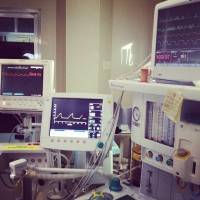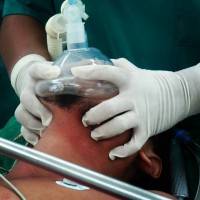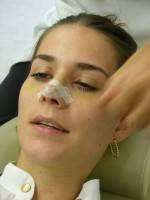Rhinoplasty Under Local Anesthesia
Rhinoplasty is a popular and effective surgery to recontour the shape of your nose. It may be done with different types of anesthesia.
If a small amount of adjusting is necessary, it may be done with local sedation. However if a large amount of bone work and fracturing may be involved, you may be more comfortable with a deeper level of sedation or with the general anesthesia.
Regardless, keep in mind that a rhinoplasty can significantly improve or change the look of your face. For this reason it is essential that you only work with a board-certified plastic surgeon who has a great deal of experience performing rhinoplasty. (Pat Pazmino, MD, Miami Plastic Surgeon)
Best Anesthesia for rhinoplasty
Most rhinoplasties are performed under 2 types of anesthesia. Conscious sedation also know as twilight anesthesia offers quicker recovery and less bleeding; however, because the patient’s consciousness waxes and wanes through the procedure, you may hear sounds that you may make you uncomfortable or anxious.
General anesthesia has a slightly longer recovery period but you are completely sedated and do not hear any of the sounds in the operating room.
Your vitals are monitored by the anesthesiologist and once the procedure is finished, you will wake up and the procedure will be over.
This is what I recommend to my patients as the most comfortable option from a rhinoplasty standpoint. (Mike Majmundar, MD, Atlanta Facial Plastic Surgeon)
Anesthesia for a Rhinoplasty (nose job)
Rhinoplasty procedures are usually performed under general anesthesia or IV sedation. If you are only having the tip of your nose improved it is certainly possible to undergo IV sedation comfortably.
However, if a more extensive rhinoplasty is going to be performed such as fracturing of the bone I find that patients are much more comfortable under general anesthesia.
Be sure to discuss these options with your surgeon and decide together. As always make sure your surgeon is Board Certified. (Scott J. Engel, MD, FACS, Sarasota Plastic Surgeon)
In the past, I have performed many rhinoplasties using local (in which you are fully awake, but numb) or IV sedation (meaning one is mostly aseleep but still may be, to some degree, aware of the procedure).
Over the past 10 to 15 years, it’s been my experience that most of my patients desire general anesthesia and that is my current preference, although I am always willing to complete the surgery with IV sedation as long as it is the patient’s choice. (Deason Dunagan, MD, Huntsville Plastic Surgeon)
Rhinoplasty under local anesthesia
Most rhinoplasty procedures that I perform are done in my office operating suites under twilight sedation- where the patient is sleeping but breathing on his/her own- and local anesthesia so nothing is felt, nor is anything remembered. However, in certain circumstances, such as when a medically indicated septoplasty procedure is required, the medical insurance requires the procedure to be performed in the hospital operating room. In other circumstances, such as when only a minor amount of tip work/sculpting is being performed, the procedure can be performed under straight local anesthesia without any sedation or perhaps oral sedation. (Jeffrey Epstein, MD, FACS, Miami Facial Plastic Surgeon)
Many options for anesthesia during a rhinoplasty exist
There are many different anesthetic options for someone considering rhinoplasty. This includes local anesthesia, twilight/ IV sedation, or general anesthesia. Each surgeon will have their own preference as to how they prefer their patients to be anesthetized. My personal preference is general anesthesia with a board-certified anesthesiologist. (Sanjay Grover, MD, Orange County Plastic Surgeon)
Sleep for Your Rhinoplasty
I do all my Rhinoplasties with my patients asleep. Rhinoplasty is precision surgery; an uncomfortable patient that moves on the table, distorts the field and can compromise your result.
Think about it, even a small bump or pinch of the nose makes you jump and your eyes water. It is a sensitive organ system.
Do not convince yourself nor let someone else convince you to have your nose done awake. Some minor tip of the nose work might be tolerated awake, but tread lightly, the last thing you would want is to have to go through secondary surgery because your result is not perfect. (John Philip Connors III, MD, FACS, Atlanta Plastic Surgeon)
Many types of anesthesia are possible in rhinoplasty
General anesthesia, the patient is completely asleep or some form of sedation by intravenous, topical agent or local can be used.
The most important consideration is to make sure that the rhinoplasty procedure can be performed safely and completely with the anesthesia proposed.
In general long or complex rhinoplasty procedures may be best performed under general anesthesia. (Robert Mounsey, MD, Toronto Facial Plastic Surgeon)
Anesthesia for Rhinoplasty
Rhinoplasty may be performed under general anesthesia, or by using local anesthesia to block the sensory nerves to the nose.
As well, internal nasal injections and packing with cocaine or neo-synephrine are done to reduce pain and bleeding. Finally, IV sedation may be combined with local anesthesia. The type of anesthesia that is right for you will be determined both by the amount and complexity of surgery you will require, and by your own anxiety level and preference. (Karen Vaniver, MD, Kennewick Plastic Surgeon)
Go to sleep for a rhinoplasty
With the exception of minor tip work on the nose I always recommend a general anesthesia for a rhinoplasty. It gives the surgeon total freedom to do whatever is necessary and also protects the patient from airway problems. (Talmage J. Raine, MD, Champaign Plastic Surgeon)
Anesthesia choice in rhinoplasty
Many patients can have Rhinoplasty performed under so called “twilight sleep”. On occasion relatively minor nasal surgery can be done under local. For more advanced surgery, including surgery on the septum would be best performed under general anesthesia.
Make sure that the choice of anesthesia is not dictated by the cost, as compromising on optimum anesthesia can lead to unsafe situation or more commonly to sub-optimal surgical result. (Boris M. Ackerman, MD, Newport Beach Plastic Surgeon)
Anesthesia choices after rhinoplasty or septoplasty
Rhinoplasty procedures vary greatly between patients and surgeons. Anesthesia choices should be made after a full medical examination and a discussion between surgeon, anesthesiologist, and patient. Most rhinoplasties are performed under general anesthesia. (Raffy Karamanoukian, MD, FACS, Los Angeles Plastic Surgeon)
Anesthesia during Rhinoplasty surgery
Most commonly, I use what is known as “twilight sleep” for Rhinoplasty. This involves closely monitored intravenous sedation, as well as local anesthetic, so that any risks, expense, and potential post operative recovery issues from a general anesthetic are eliminated. However with IV sedation, you are sleepy enough and completely anesthetized, so that no pain is felt during the surgery. (Michael R. Macdonald, MD, Bay Area Facial Plastic Surgeon)
Type of Anesthesia Used During Rhinoplasty
Rhinoplasty can be performed under local anesthesia, IV sedation or general anesthesia, depending on the patient’s medical history and the complexity of the procedure. In most instances, rhinoplasty is performed under general anesthesia to allow for the surgeon to best perform his work without making the patient feel uncomfortable. (Tarick K. Smaili, MD, Beverly Hills Plastic Surgeon)
Anesthesia for Rhinoplasty
I have performed Rhinoplasty using I.V. Sedation with local anesthesia and also using General Anesthesia.
From the surgeon’s perspective General Anesthesia ensures patient comfort and allows the surgeon to work the most efficiently.
Sedation is a perfectly acceptable alternative provide adequate monitoring is used and the patient prefers that particular approach.
With surgery involving a severely deformed nasal septum and lengthy revision surgeries I prefer general anesthesia. (Jon F. Harrell, DO, Miami Plastic Surgeon)
Most Rhinoplasties are performed under general or IV sedation
Although Rhinoplasty can be performed under local anesthesia, most facial plastic and plastic surgeons prefer iv sedation of general anesthesia so that the patient would be comfortable and still.
This is even more important in cases were an individual is anxious, or the procedure is long and complicated. (Amir Moradi, MD, San Diego Facial Plastic Surgeon)
Usually rhinoplasty is done under general anesthesia by a board certified anesthesiologist. (Jaime Perez, MD, Tampa Plastic Surgeon)
Anesthesia and rhinoplasty
IV sedation anesthesia administered by an experienced board-certified anesthesiologist is my preferred technique for rhinoplasty.
This will vary depending upon patient medical condition, patient desire, and complexitiy of surgery. For example, if a patient needs a difficult revision with rib grafting, general anesthesia is the only choice in my practice. Almost any other type of rhinoplasty can be performed under IV sedation. If sinus surgery is required at the same time, then again general anesthesia is required. Most anesthesia-related complications following rhinoplasty have to do with surgeon inexperience, anesthesiologist inexperience, or both.
Make sure your surgeon is operating in an accredited facililty he is familiar with and that the anesthesiologist is equally experienced. Some surgeons will also offer this surgery under local anesthesia with very mild sedation they administer themselves. Again, with experience this can also be a safe way to perform the surgery. (Minas Constantinides, MD, Manhattan Facial Plastic Surgeon)
Anesthesia for Rhinoplasty- Safety First
Functional rhinoplasty (insurance involved because you can’t breath) are done in the hospital under general anesthesia. Cosmetic rhinoplasty is done in the office-based OR under sedation with an anesthesiologist assisting (MD trained to administer anesthesia). Although I do most my in-office cosmetic surgery with a nurse administering the anesthesia, rhinoplasty is different.
In this situation, operating on the airway with blood that inevitably goes back in the throat, there is risk of aspirating the blood or even frank obstruction of the airway. If that happens, I want someone there trained in airway management who knows how to quickly use the tools available.
Although the risk is small, it’s well worth the extra couple hundred dollars to prevent a disaster from happening. It’s just the SAFER way to do it. (John Bitner, MD, Salt Lake City Facial Plastic Surgeon)
Rhinoplasty may be done safely under Sedation or General Anesthesia
While many surgeons may prefer one type of anesthesia or the other, rhinoplasty is actually performed very safely under either sedation or general anesthesia.
I personally prefer sedation for most patients; there is dramatically less bleeding under sedation than general, due to the general anesthesia’s effects on blood vessels.
With less bleeding, the rhinoplasty goes more quickly and smoothly, with less postoperative bruising and swelling as well. As a matter of fact, there is no reason – other than the initial pain of injection and/or nervousness – that rhinoplasty cannot be performed totally safely and comfortably under local anesthesia alone! (Laxmeesh Mike Nayak, MD, Saint Louis Facial Plastic Surgeon)
Kind of anesthesia used for rhinoplasty
Most surgeries are performed under general anesthesia, or deep sedation. In a small minority of cases, when only little tip work or nostril narrowing is desired, local anesthesia may be used. (Maurice M. Khosh, MD, New York Facial Plastic Surgeon)
I prefer having my patients asleep for rhinoplasty. I think it is safer. The amount of anesthetic given is lower than in many operations because we also use local anethestic directly in the nose.
We also take many precautions to try to make sure that our patients do not have nausea and vomiting after surgery. Our patients seem happy to go to sleep for the procedure.
We will do some minor revisions in the office with just local anesthetic and some Valium and/or Percocet pre op. (Stuart H. Bentkover, MD, Boston Facial Plastic Surgeon)
Choosing anesthesia for rhinoplasty
Nose surgery can be done using three different types of anesthesia. You can have local, local with sedation, and general.
Using local you may have moments of feeling pain which will require more injections of local anesthesia. The injections themselves hurt.
Unless you are having a very small procedure I do not recommend purely local anesthesia for rhinoplasty. By adding sedation you will be much more comfortable.
You may still have moments of pain but you will not likely remember anything about surgery. The most comfortable option is general anesthesia. You go to sleep, and wake up once the operation is completely done.
You won’t remember anything about surgery and won’t feel anything at all during surgery. General anesthesia, however, may take a little longer to wake up from after surgery and may cause more nausea depending upon the medications used. You should discuss your options with your surgeon and your anesthesiologist. All techniques can be used very safely. (Adam Rubinstein, MD, Miami Plastic Surgeon)
Anesthesia for rhinoplasty can vary. I use either deep sedation or general anesthesia for most patients. I think they are more comfortable which then allows me to do the best job that I can. (Steven Wallach, MD, Manhattan Plastic Surgeon)
Type of Anesthesia for Rhinoplasty Depends on Extent of Surgery
There are two main types of anesthesia that are used when rhinoplasty is performed: (1) general anesthesia, and (2) iv sedation with local anesthetic injection. The type of anesthesia that is used will vary from surgeon to surgeon and also will depend on the length of your surgery and the extent of work that needs to be done. Minor nose reshaping is often performed with patients under iv sedation. In this instance, medication to make patients drowsy and to decrease anxiety are given through an IV and patients continue to breath on their own.
Local anesthetic medication – such as lidocaine – is injected into the skin of the nose to decrease discomfort. More extensive surgery typically requires patients to be completely asleep using general anesthesia. In this instance, an anesthesiologist administers anesthetic gas and oxygen via a tube placed through the mouth that extends into the windpipe. The advantage of this type of anesthesia protects the patients lungs from aspirating (breathing in) and secretions or blood from the throat. Discuss with your surgeon which type of anesthesia is right for you and why. (C. Spencer Cochran, MD, Dallas Facial Plastic Surgeon)
General anesthesia for rhinoplasty
Most surgeons now adays use general anesthesia because our techniques are much more sophisticated and complex then they used to be and therefore the surgery takes longer now then it used to in the 80’s and 90’s. (Jason B. Diamond, MD, Beverly Hills Facial Plastic Surgeon)
I feel very strongly that nasal surgery should only be done with intravenous sedation and local anesthesia. This is a very safe technique and the patient remembers nothing of the procedure. I have performed over 5000 rhinoplasties and have never once used general (complete) anesthesia. There are several reason why. Among the, patients bleed much more under general anesthesia, making it very difficult for the surgeon to see; and there are rare occasions where general anesthesia has caused a death. (Howard T. Bellin, MD (retired), Manhattan Plastic Surgeon)
Anesthesia for Rhinoplasty
Anesthesia for rhinoplasty can be done in many ways. Many doctors use general anesthesia, that is ,the patient is completely asleep and the airway is protected. Sedation anesthesia can also be used where the patient is given sedation after which local anesthesia is injected to give pain relief. Both ways are safe in the right hands. Ask your doctor before you undergo surgery so that you are well informed. (Carlos Wolf, MD, Miami Facial Plastic Surgeon)


